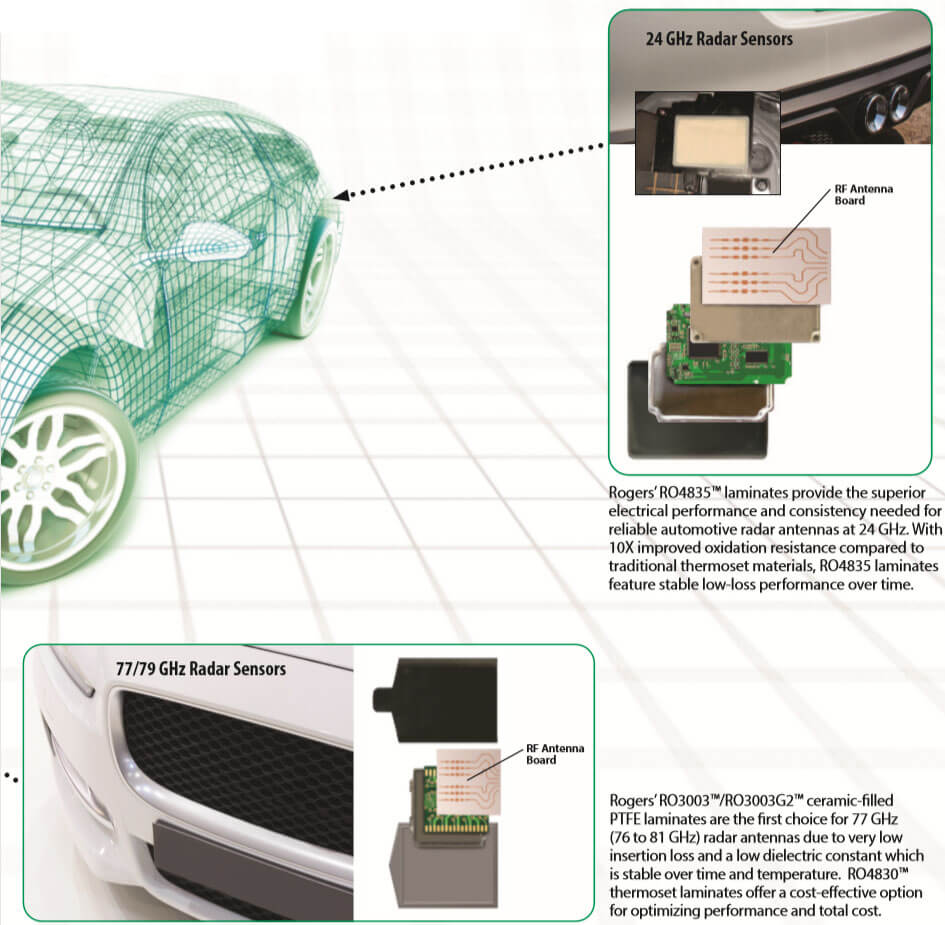RO3003G2 high frequency pcb material
Rogers RO3003G2 high-frequency, ceramic-filled PTFE laminates are an extension of Rogers’ industry leading RO3003 solutions. RO3003G2 laminates are based on industry feedback to specially address the next generation needs for mm-wave automotive radar applications.
RO3003G2 laminate's combination of optimized resin and filler content provides a lower insertion loss, ideal for use in ADAS systems like adaptive cruise control, forward collision warning and active brake or lane change assist.
RO3003G2 high frequency pcb material Features
Dielectric constant of 3.00 at 10 GHz and 3.07 at 77 GHz
Very Low Profile (VLP) ED copper
Homogeneous construction incorporating VLP ED copper and reduced dielectric porosity
Enhanced Filler System
Benefits
Best in class performance for insertion loss
Minimize dielectric constant variation in finished PCB
Enable trend toward more small diameter vias
Global manufacturing foot print

Advantages of 77GHz band in automotive and industrial applications
Advantage 1: high range resolution and ranging accuracy
Compared with the ISM band with only 200MHz bandwidth in 24GHz band, the SRR band in 77GHz band can provide up to 4GHz scanning bandwidth, significantly improving the range resolution and accuracy. Among them, range resolution represents the ability of radar sensor to separate two adjacent objects, and range accuracy represents the accuracy of measuring a single target.
Because the range resolution and accuracy are inversely proportional to the scanning bandwidth, the performance of 77GHz radar sensor is better than that of 24GHz radar, which is 20 times higher than that of 24GHz radar. In fact, the range resolution of 77GHz radar is 4cm (the resolution of 24GHz radar is 75cm).
High range resolution can better separate objects (such as people standing near cars) and provide dense points to detect objects, so as to improve the environment modeling and object classification, which is very important for the development of advanced driving assistance algorithm and automatic driving function.
In addition, the higher the resolution, the smaller the minimum distance of sensor recognition. Therefore, 77-81ghz radar has a significant advantage in applications requiring high accuracy, such as parking aid.
The 77GHz broadband has high resolution, which can be used for industrial level sensor, so that the sensor can "measure to the last drop" of liquid level - to minimize the dead zone at the bottom of the water tank, as shown in the figure. Moreover, because the high resolution can improve the minimum measurement distance, when the water tank is full, the sensor can measure the liquid level at the top of the water tank.
Advantage 2: high speed resolution and precision
The speed resolution and accuracy are inversely proportional to the radio frequency (RF) frequency. Therefore, the higher the frequency, the better the resolution and accuracy. Compared with the 24 GHz sensor, the 77 GHz sensor can reduce the power consumption.
For parking aid applications, speed resolution and accuracy are crucial, because it is necessary to operate the vehicle accurately at low speed when parking. Fig. 4 shows a representative FFT range velocity image of a point object at 1 m and depicts an improved resolution of a two-dimensional image obtained using 77 GHz.
In addition, recent studies have further improved pedestrian detection and advanced object classification algorithms by using radars with higher resolution and micro Doppler signals. The improvement of speed measurement accuracy is conducive to industrial applications, but also to improve the current situation of traffic detection under the background of automatic vehicles.
Advantage 3: smaller size
One of the main advantages of higher RF frequency is that the sensor size can be smaller. For the same antenna field of view and gain, the size of 77GHz antenna array can be reduced about three times in X and Y dimensions. This size reduction is very useful in the car, mainly reflected in the application around the car (including the door and trunk that need to install the proximity sensor) and in the car.
In the aspect of industrial fluid horizontal line sensing, higher RF frequency can provide narrower beam for antennas and sensors of the same size. The narrow beam can reduce the unnecessary reflection from the side of the tank and the interference of other obstacles in the tank, so as to obtain more accurate measurement results. In addition, for the same beam width, the higher the RF frequency, the smaller the size of the sensor and the easier to install.
If you have any problem, pls feel free to contact me: kaixuanhe0@gmail.com whatsapp:+86 13923107710